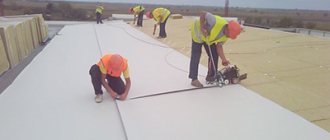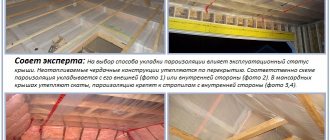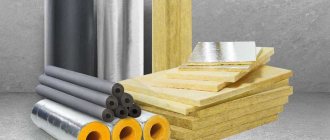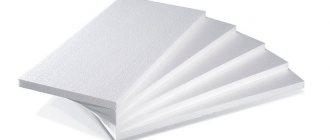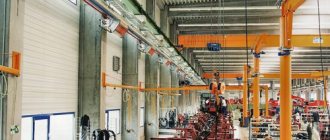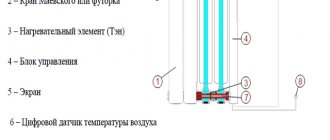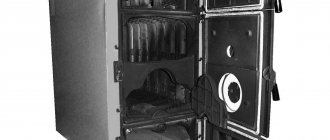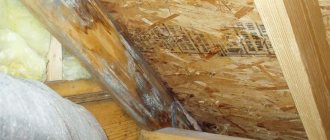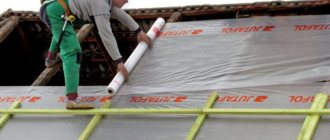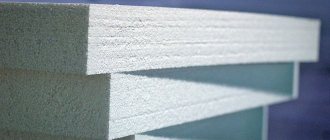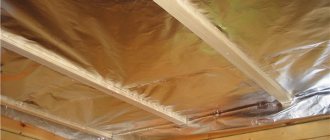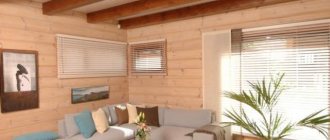Vapor barrier for walls is a solution to the problem of protecting a structure from the direct action of water vapor. Steam can degrade the performance of many building materials. It provokes the appearance of mold on the walls and reduces the service life of structures. Therefore, laying a vapor barrier is an extremely important stage in the construction of various facilities.
Vapor barrier membrane - a modern material for effective vapor barrier
Why is a vapor barrier necessary?
Installing a vapor barrier on walls is especially necessary in rooms where there are simultaneously fairly warm temperatures and high humidity. Examples include bathhouses, as well as heated basements. Inside these structures, steam is formed, that is, warm air with small drops of water.
The directions of exit from the room for him are the ceilings and walls. Gradually, due to constant vapor formation, the surface of structures is destroyed, so vapor barrier is a necessary measure during construction.
Operating principle of vapor barrier for wall structures
So why do you need vapor barrier for walls in buildings? It is this that creates an obstacle to the penetration of vapors, thereby preventing the destruction of the walls of the facility. Vapor barrier may be required not only in basements and bathhouses, but also in many other structures.
Its device is advisable if the outside of the object is insulated with a material characterized by low diffusion resistance. It is worth understanding that there is no universal insulating material, and it is necessary to select a vapor barrier according to the object and the properties of its structures.
Where vapor barrier is required
There are a number of situations in which it is necessary to install a vapor barrier.
These include the following:
- Vapor barrier of walls from the inside, especially in situations where cotton wool materials are used as thermal insulation. Glass wool and mineral wool have excellent thermal insulation properties and are part of the range of materials that allow air to pass through well. Their disadvantage is the fear of high humidity. When exposed to liquid or steam, cotton materials become wet and lose their performance characteristics, and over time they completely collapse. Installing a vapor barrier will help avoid such consequences.
- Multilayer wall structures used in frame houses. Frame structures need to provide effective vapor barrier. The procedure for installing vapor barrier material in a frame house will be discussed in detail below.
- Ventilated facades and the surface of external walls require a vapor barrier to provide protection from the wind. Vapor barrier materials make the air flow softer and make it more metered. This allows you to protect the outer insulating layer from overload. An example is a brick wall, which is insulated with a cotton-type material and then covered with siding. Thanks to the vapor barrier, a reduction in wall blowing is achieved. The ventilation gap allows you to remove excess moisture from the windproof surface.
An important factor that allows you to ensure an acceptable microclimate in any room, except for steam and thermal insulation, is functioning ventilation.
Vapor barrier materials
It is possible to install a vapor barrier using a variety of materials. The very concept of “vapor barrier” does not mean that the barrier should completely block the circulation of steam. A modern vapor barrier membrane ensures a minimum air flow to prevent the greenhouse effect indoors.
The membrane retains excess moisture, and the air that was part of the steam is not capable of damaging walls and heat-insulating materials. Vapor barrier materials can redirect air flow to the exhaust ventilation system.
Polyethylene used for vapor barrier
The following types of vapor barrier materials can be laid on the walls:
- Polyethylene. It is a traditional material for creating a vapor barrier layer. Such a vapor barrier must be attached to the wall with care, without excessive tension. It is important that conditions are not created for the film to break through when the season changes. You need to understand that in the absence of perforation of polyethylene, this material limits the flow of both steam and air, which creates obstacles to creating a comfortable microclimate in the room. However, perforation no longer provides good vapor barrier for insulating material and walls. This type of vapor barrier is used less and less in modern construction.
- Mastic materials. This material is applied to the wall, allows air to pass through and retains excess moisture. Wall treatment is carried out before finishing finishing manipulations are carried out. Mastic materials are relatively inexpensive and easy to use.
- Membrane films. This type of vapor barrier is the most modern. The film allows air to pass through and stops moisture. The material is characterized by the correct value of vapor permeability to ensure acceptable insulation properties. Even cotton insulation materials, when using membrane films as a vapor barrier, do not get wet, retain the ability for normal air exchange and do not lose their performance characteristics. Membrane vapor barrier materials are convenient to use for insulating both frame and wooden walls.
When choosing membrane films, there is often no need to install air gaps.
Advantages of membrane materials
Membrane films are a priority when it comes to choosing a vapor barrier material. Mastics are in second place in terms of efficiency, and polyethylene films are used relatively rarely in modern construction.
The advantages of membrane films compared to other vapor barrier materials include:
- high operating efficiency;
- ease of installation;
- strength;
- good ability to repel moisture;
- ensuring the resistance of the wall surface to the proliferation of mold microorganisms;
- resistance to decay processes;
- environmental friendliness of the material;
- long service life - the film retains its original properties for 50 years;
- wide operating temperature range (from -60 to +80 degrees Celsius).
Thus, the advantages of choosing vapor barrier membranes are obvious, which determines their increasing popularity in the construction market.
Types of membrane materials
The range of materials for vapor barriers on the modern construction market is very wide. You should consider the types of membrane materials that have already earned their authority among consumers:
- Membranes that can be attached to the outside of the thermal insulation (it is external to the space of the room). These include the following brands: “Izospan A”, “Megaizol SD”, “Megaizol A”. These membranes are used to protect the outside of the walls of frame structures, timber, panel and combined buildings from a variety of atmospheric phenomena: wind, snow, rain.
The membrane must fit tightly to the insulating material, be securely fixed to the mounting structure, and have no sagging areas (they provoke popping noises during sudden gusts of wind).
Might be interesting
Vapor barrier
Effective and simple solutions for insulating ceilings in…
Vapor barrier
Technologies and materials for effective thermal insulation of floors in…
Vapor barrier
Vapor barrier and waterproofing, is there a difference?
Vapor barrier
Features of vapor barrier of a wooden building
- Membranes that can be placed on the inside of walls. These include: “Megaizol V”, “Izospan V”. This type of membrane materials protects walls from fungus, condensation, and corrosion of structural elements. Also, such membranes prevent particles of insulating material from entering the space of the structure.
- Membranes including a reflective layer. These include: “Izospan FS”, “Izospan FD”, “Izospan FX”. They are used for the purpose of vapor barrier in premises such as saunas and baths.
It is necessary to select a material for vapor barrier strictly according to the purpose of use. This allows you to create optimal conditions for creating a comfortable indoor climate.
What type of vapor barrier is there?
As you already understood, if insulation is installed in the floor structure, which absorbs water and changes its properties when wet (mineral wool in any form, for example), it is necessary to take measures to ensure that moisture in no form penetrates into the insulation. This is why vapor barrier materials are used.
A vapor barrier is a material that does not conduct water vapor. There are two types:
- with one-way conductivity;
- vapor-tight.
With one-way conductivity - these are membranes. They are more like non-woven fabric. In any case, on one side they have non-woven fabric. They do not allow steam to pass in one direction, but they do so in the other. This type of material appeared not so long ago, and if it “works” as it should, it’s a very good thing. But while there is little experience in using it, they are trying to avoid it.
Types of vapor barrier: membrane, film, with heat reflection. Which side to lay the vapor barrier is important for membranes and materials with a shiny coating
Materials that do not conduct steam at all, in any direction, are made on the basis of film. Most often this is polyvinyl chloride film (PVC), but other polymers can be used. The most durable polystyrene, but it is also the most expensive. Vapor-proof films can be reinforced - three-layer or without reinforcement.
There are also vapor barrier materials with a heat-reflecting effect. They can be distinguished by a shiny surface on one side (there are materials on both sides that reflect heat). A shiny surface can be:
- thin foil glued to the surface;
- metallized lavsan;
- metallized polypropylene.
What is metallized film used for? It reflects thermal radiation into the room. This way you can save on heating costs. Here's just one thing: reflection works when there is an air gap. That is, in a floor pie it makes sense to use such a film in floors along joists. It can be used to cover mineral wool, spreading a reflective shiny layer into the room.
Installation of vapor barrier film on walls
Installation of vapor barrier on walls is used in cases where mineral materials are used as thermal insulation. It is important to follow the correct installation procedure for the vapor barrier film.
It includes the following stages of work:
- The vapor barrier film must be positioned on the desired side, and then carefully and securely fastened to the sheathing. In this case, you need to work carefully so as not to damage the film.
- Then you need to carefully glue any possible cracks, as well as punctures and overlaps.
- Next, you need to install the sheathing using beams to create acceptable ventilation.
- Then the structure is covered with plasterboard, wall panels, and other finishing materials.
Correct installation of the vapor barrier film will ensure a comfortable microclimate in the room.
Recommendations for vapor barrier of frame structures
You need to understand how to properly install vapor barrier in frame houses. To do this, you must first install the membrane on the required side, and then secure it to the racks with a stapler. Next, you should glue the joints using special tape or mastic.
When using ecowool, polyurethane foam, polystyrene foam as insulating material and provided there is an effective ventilation system, a vapor barrier layer in the frame structure may not be required.
Organization of vapor barrier for frame structures
If there is still a need for vapor barrier, then one of two possible schemes should be used:
- The vapor barrier is sewn onto the frame posts. How to attach a vapor barrier in this case? First, the film is fixed on the racks, after which the walls are lined with clapboard, plasterboard or other interior finishing materials. This option can be used in buildings used for seasonal purposes, which are not needed during the cold season. These include guest buildings, country houses, and workshops. This option involves ensuring effective ventilation of the structure.
- It involves installing a layer of sheathing (horizontal or vertical) above the membrane. The lathing is necessary to provide an air gap of 30 to 50 millimeters from the wall surface. This option is advisable to use in permanent homes or buildings that require intensive use during the cold season.
The choice of installation scheme for vapor barrier in a frame house should be made based on the expected intensity and seasonality of use of the room.
Material requirements
First of all, a vapor barrier film or any other material cannot be a membrane by definition. The properties of membrane fabrics include the ability to protect insulation from weathering and not allow water to pass through, but allow steam to pass through.
The simplest types of vapor barrier are polyethylene film with a thickness of at least 200 microns and glassine (obsolete and rarely used). To create a vapor-tight layer, foil-coated thin-sheet materials are also used, which also act as reflective thermal insulation.
Manufacturers of vapor barrier materials produce special two-layer films that have the ability to absorb and retain some of the moisture from the air. One of their sides has a rough or fleecy “anti-condensation” surface, which is turned indoors when installed.
Vapor barrier of walls in wooden houses
Structures made of wooden materials require special vapor protection. Wooden houses are characterized by high vapor permeability of walls in comparison with brick and stone walls. This indicator is determined by the thickness of the timber and logs, the presence of cracks, and the impermeability of the grooves to moisture and steam.
Glued laminated timber, which is used to build walls, must be dried in production to an acceptable humidity level . It should also have sealing grooves and low shrinkage. All this is necessary to limit the flow of steam into the insulation.
Timber or log walls with natural moisture levels are dried directly during use. Due to shrinkage within 5 years, deformations and cracks appear on the walls. Logs and beams change their dimensional characteristics, the grooves lose their tightness.
Therefore, you should not carry out interior finishing for 5 years - this will not allow access to the grooves to restore the tightness. In such a situation, there are two options: either wait for the wood to dry completely, or organize a vapor barrier using membranes such as “Izospan FB”, “Izospan B”, “Izospan FS”.
Organization of vapor barrier of wooden buildings
The vapor barrier must form a single contour with the attic and basement floors of the structure.
How does vapor barrier work in insulated structures?
Water vapor is always present in the air. Several factors influence moisture concentration:
- sources of vaporization;
- air temperature;
- Atmosphere pressure.
In the process of life, a person actively “generates” steam: personal hygiene, cooking and drinking, washing, wet cleaning, washing dishes. The person himself, pets and indoor plants also evaporate moisture.
Even at the level of standards, it is believed that in the warm season the humidity conditions indoors and outdoors are the same. The temperature difference is small, and natural ventilation and airing equalize the air humidity inside and outside.
In cold weather, the situation changes - inside the heated room the level of air humidity is higher than outside. Ventilation cannot completely solve this problem. And a large temperature difference leads to an increase in the partial pressure (elasticity) of water vapor, which creates conditions for moisture transfer through the enclosing structures from the inside to the outside.
In winter, the temperature of enclosing structures changes from “plus” indoors to “negative” outside. In the walls of the attic and the ceilings of cold attics, a so-called “dew point” appears - a conditional surface where warm, moist air cools down to the temperature of condensation.
Inside “single-layer” structures made of dense material, condensation physically cannot form - there is no room. In two- and three-layer structures, the dew point shifts towards a less dense material with low thermal conductivity - into the insulation.
If this material has a loose or fibrous structure, then it begins to get wet due to condensation. And wet insulation loses its thermal insulation properties, swells, and its volume and weight increase.
Bulk thermal insulation of the attic floor or mineral wool, which is used to insulate the ceiling and roof, must be protected from water vapor. This is why a vapor barrier is needed, which is a continuous vapor-proof layer in the path of warm, moist air.
